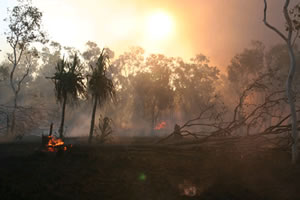The projects › AÏDA
Advancing ICT for DRM in Africa
Summary
Many Developing Countries in Africa are exposed to serious environmental disaster risks. Disasters can often not be prevented, but the loss caused by these events could be limited. ICT solutions could be successfully used in almost all phases of the disaster management process to minimize the impact. In the disaster mitigation and preparedness process, ICT is widely used to create early warning systems. In the immediate aftermath of a disaster, other ICT solutions could be used for emergency relief. In addition, geographic information systems (GIS) and remote sensing software could be effectively used in all phases of DRM.
On top of this, the need for adequate ICT information in Africa is high. Many countries are setting up National Disaster Plans in order to implement the Hyogo framework for action, as agreed during the World Conference on Disaster Reduction in Kobe/Japan in January 2005.
Various UN initiatives (e.g. UN/ISDR) provide a rich wealth of disaster information to Africa.
Unfortunately, knowledge of and access to affordable ICT systems in support of DRM (both early warning, alert and emergency management systems) is hard to find and often lacking.
AÏDA wants to fill this gap in a manner which works in Africa, the bottom-up approach. It is not intended to push any technology top-down, but to focus on existing and working concrete examples and encourage people to learn from each other. The ultimate ambition is to share and promote best practices amongst stakeholders in Africa to encourage the wider deployment of proven successful ICT solutions in Disaster management in Africa across all different countries and communities.
Therefore, the AÏDA project will:
- assess the natural hazards, the vulnerability of the communities and the disaster risks in Africa;
- assess the role of ICT based systems in each hazard category;
- explore the ICT trends and needs for the future;
- test the usefulness of GEONETCast as an alert system;
- share this information with all DRM stakeholders in Africa (by workshops and other);
- prepare 3 showcases of operational African DRM systems for demo on these workshops;
- promote and support the take-up of this technology for use in other disasters;
- liaise with any new project in DRM with a significant involvement of African partners.
On top, AÏDA will also test whether the existing GEONETCast infrastructure can be reused as an alert or emergency system. AÏDA sets up a testcase in South-Africa where the Forest Fire Association in Nelspruit, South-Africa will use the wildfire-alarms from CSIR within their operational activities to fight wildfires. If successful, many DRM systems can benefit from this technology.
The project is envisioned to have a big impact with a limited budget, by close cooperation with the AARSE and EUMETSAT conferences and within the UNeDRA network. The consortium is balanced and contains 4 African and 4 European partners and combines a strong ICT expertise (TSF, VITO, CSIR and EUMETSAT) with a strong disaster expertise (ITC, ARU, IER and FUTM), all with a strong relationship with Africa.
This effort will support authorities in Developing Countries in setting up their National Disaster Plans (as required by the Hyogo agreements) by offering knowledge about working ICT solutions and help them to better manage their disaster risks.
Partners

Bush fire, Senegal
Progress
Total progress:  41 %
41 %
Fields of action
This project covers the following domains:
Funding
This project is co-funded by European Commission.
TSF role
Technologies Sans Frontières, thanks to the experience of its members in occidental countries as well as in Africa, takes in charge the WP3 "Exploring ICT trends for DRM in Africa" of the AÏDA project.
As a non-profit organisation working in the field of ICT, TSF has a good vendor-independent overview of all ICT solutions on the continent and the needs for the future.












